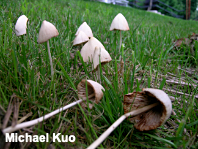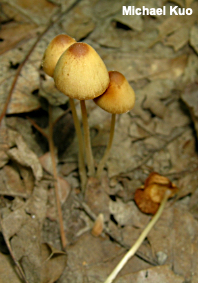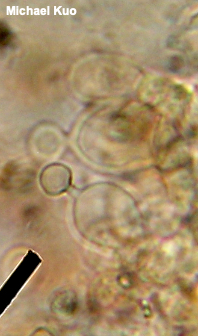| Major Groups > Gilled Mushrooms > Dark-Spored > Conocybe & Pholiotina |

|
[ Basidiomycota > Agaricales > Bolbitiaceae . . . ] The Genera Conocybe & Pholiotina by Michael Kuo, 10 November 2023 Conehead. That's English for Cono-cybe, a genus consisting of dozens of frustratingly similar LBMs (Little Brown Mushrooms) requiring microscopic analysis for confident identification. The genus itself is fairly easy to recognize: look for the small, conical caps ranging from whitish to some shade of brown, the long and fragile stems, and the rusty brown mature gills and spore print. Species of the closely related genus Pholiotina are similar, but feature a partial veil that leaves a ring on the stem and/or fragments on the margin of the young cap. But while the genera are recognizable with a little practice, identifying species is not for the faint of heart. If you are in Europe, there are at least three thorough treatments available to you: Watling 1982, Arnolds 2005, and Hausknecht & Vesterholt 2018 (see the references list below). If you are in North America, however, there is no comprehensive treatment and you will be forced to use the European sources and species names (incidentally, although these sources are readily available, none of them is cheap; interlibrary loan may be your best option). North American species have been named for two centuries by the usual suspects (Peck, Murrill, and so on). But while the available type collections have been studied under the microscope (Hausknecht et al. 2004), an overall assessment of what species occur in North America has not been assembled. The microscopic characters you will need to assess for identification of Conocybe and Pholiotina collections are four: spores, basidia, the cheilocystidia on the edges of the gills, and the caulocystidia on the surface of the stem. Spore morphology in Conocybe and Pholiotina is usually a matter of basic measurements, and analysis of basidia is a matter of counting spore prongs to determine whether the basidia are 2- or 4-sterigmate. To look at cheilocystidia, a Roman aqueduct section is your best bet. If the cheilocystidia are lecythiform (shaped like bowling pins) you are in the genus Conocybe; if they're otherwise shaped you're in Pholiotina. The most frustrating and time-consuming character is the caulocystidia. You will need a razor-thin strip section from the surface of the stem (about halfway down), and you may need to make several attempts, since caulocystidia do not usually cover the entire stem surface. You are attempting to determine whether the caulocystidia are lecythiform—and, if so, whether all the caulocystidia are lecythiform, or whether the lecythiform cystidia are mixed with other cystidia types: lageniform, ellipsoid, clavate, filiform, and so on. If all of this sounds like fun to you, by all means have at it. I should add, however, that the reigning European species concepts are for the most part not yet investigated with contemporary, DNA-informed research, and that once some mycologist somewhere tackles the mammoth task of revising Conocybe and Pholiotina, things may look very different. I have not made a key to Conocybe and Pholiotina, since the European keys I listed above and cite below in full are readily available—and because it seems like a potential waste of time in the absence of phylogenetic species concepts. Also, I haven't collected many of the species (by design, lol), so I lack the experience that would inform a good key. The species I have collected or studied are: Conocybe apala |
|
|
References Amandeep, K., N. S. Atri & K. Munruchi (2015). Diversity of species of the genus Conocybe (Bolbitiaceae, Agaricales) collected on dung from Punjab, India. Mycosphere 6: 19–42. Arnolds, E. & A. Hausknecht (2003). Notulae ad floram agaricinam Neerlandicam—XLI: Conocybe and Pholiotina. Persoonia 18: 239–252. Arnolds, E. (2005). Conocybe Fayod. In Noordeloos, M. E., Th. W. Kuyper & E. C. Vellinga, Flora Agaricina Neerlandica: Critical monographs on families of agarics and boleti occurring in the Netherlands, Vol. 6. Boca Raton: Taylor & Francis, 120–179. Arnolds, E. (2005). Pholiotina Fayod. In Noordeloos, M. E., Th. W. Kuyper & E. C. Vellinga, Flora Agaricina Neerlandica: Critical monographs on families of agarics and boleti occurring in the Netherlands, Vol. 6. Boca Raton: Taylor & Francis, 180–203. Hallen, H., R. Watling & G. Adams (2003). Taxonomy and toxicity of Conocybe lactea and related species. Mycological Research 107: 969–979. Hausknecht, A., I. Krisai-Greilhuber & H. Voglmayr (2004). Type studies in North American species of Bolbitiaceae belonging to the genera Conocybe and Pholiotina. Österreichische Zeitschrift für Pilzkunde 13: 153–235. Hausknecht, A. & I. Krisai-Greilhuber (2006). Infrageneric division of the genus Conocybe—a classical approach. Österreichische Zeitschrift für Pilzkunde 15: 187–212. Hausknecht, A. & I. Krisai-Greilhuber (2007). Infrageneric division of the genus Pholiotina—a classical approach. Österreichische Zeitschrift für Pilzkunde 16: 133-145. Hausknecht, A. & J. Vesterholt (2018). Conocybe Fayod. In Knudsen, H. & J. Vesterholt, eds., Funga Nordica: Agaricoid, boletoid, clavarioid, cyphelloid and gastroid genera. Copenhagen: Nordsvamp, 735–755. Hausknecht, A. & J. Vesterholt (2018). Pholiotina Fayod. In Knudsen, H. & J. Vesterholt, eds., Funga Nordica: Agaricoid, boletoid, clavarioid, cyphelloid and gastroid genera. Copenhagen: Nordsvamp, 756–762. Prydiuk, M. P. (2007). New records of Conocybe species from Ukraine. I. The sections Mixtae and Pilosellae. Česká Mykologie 59: 25–38. Prydiuk, M. P. (2007). New records of Conocybe species from Ukraine. II. The section Conocybe. Česká Mykologie 59: 39–50. Prydiuk, M. P. (2014). Some Conocybe species rare or new for Ukraine. 1. Section Conocybe. Österreichische Zeitschrift für Pilzkunde 23: 1–19. Sammut, C. & A. Melzer (2013). Conocybe from Malta. Micologia e Vegetazione Mediterranea 28: 127–134. Singer, R. & P. Ponce de Leon (1982). Galeropsidaceae west of the Rocky Mountains. Mycotaxon 14: 82–90. Siquier, J. L. & J. C. Salom (2017). Il genere Pholiotina nelle Isole Baleari (Spagna)—I Pholiotina mediterranea sp. nov. Rivista di Micologia 60: 213–236. Tóth, A., A. Hausknecht, I. Krisai-Greilhuber, T. Papp, C. Vágvölgyi & L. G. Nagy (2013). Iteratively refined guide trees help improving alignment and phylogenetic inference in the mushroom family Bolbitiaceae. PLoS ONE 8: e56143. Watling, R. (1982). Conocybe Fayod. In Watling, R., British Fungus Flora, Agarics and Boleti, 3: Bolbitiaceae: Agrocybe, Bolbitius & Conocybe. Edinburgh: Her Majesty's Stationery Office, 39–102. Watling, R. & A. Hausknecht (1997). Conocybe anthuriae, a new volvate species from Mauritius (Africa). Österreichische Zeitschrift für Pilzkunde 6: 55–59. This site contains no information about the edibility or toxicity of mushrooms. Cite this page as: Kuo, M. (2023, November). The genera Conocybe and Pholiotina. Retrieved from the MushroomExpert.Com Web site: http://www.mushroomexpert.com/conocybe.html © MushroomExpert.Com |



